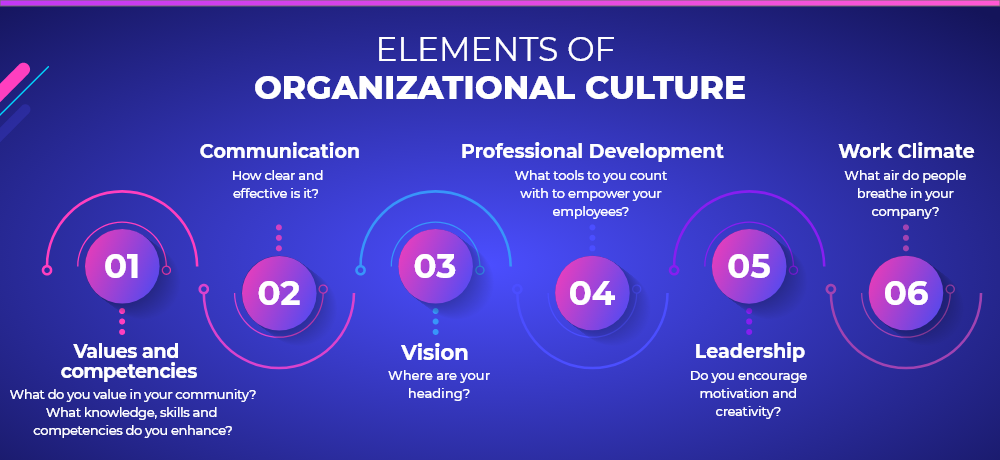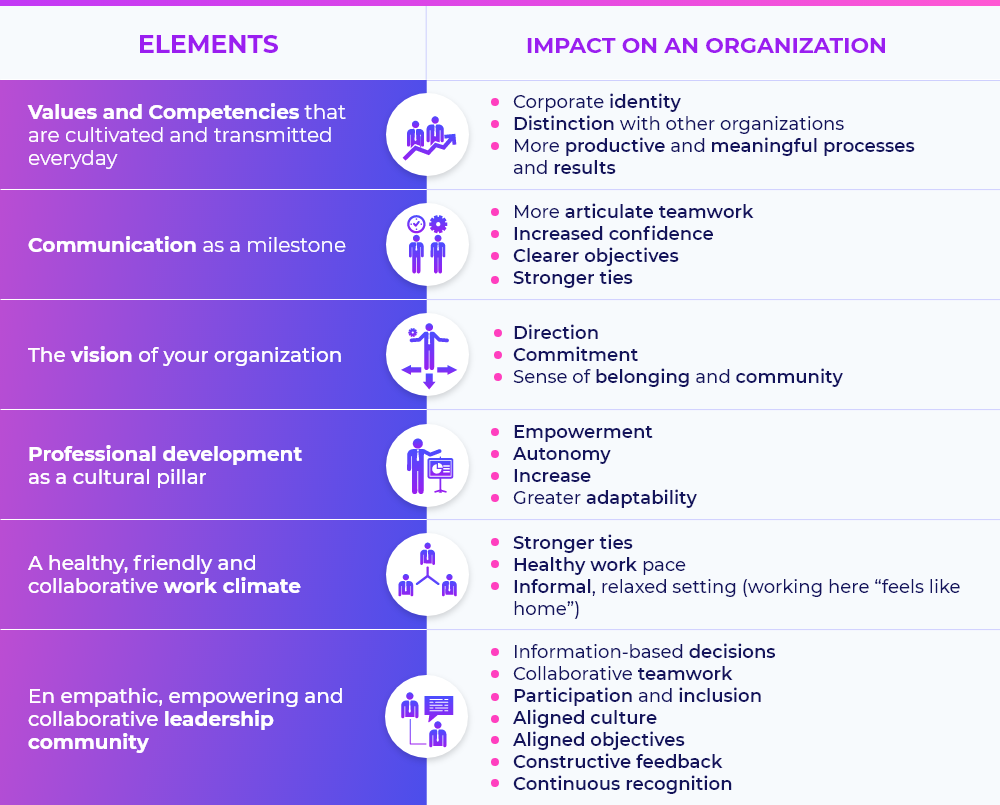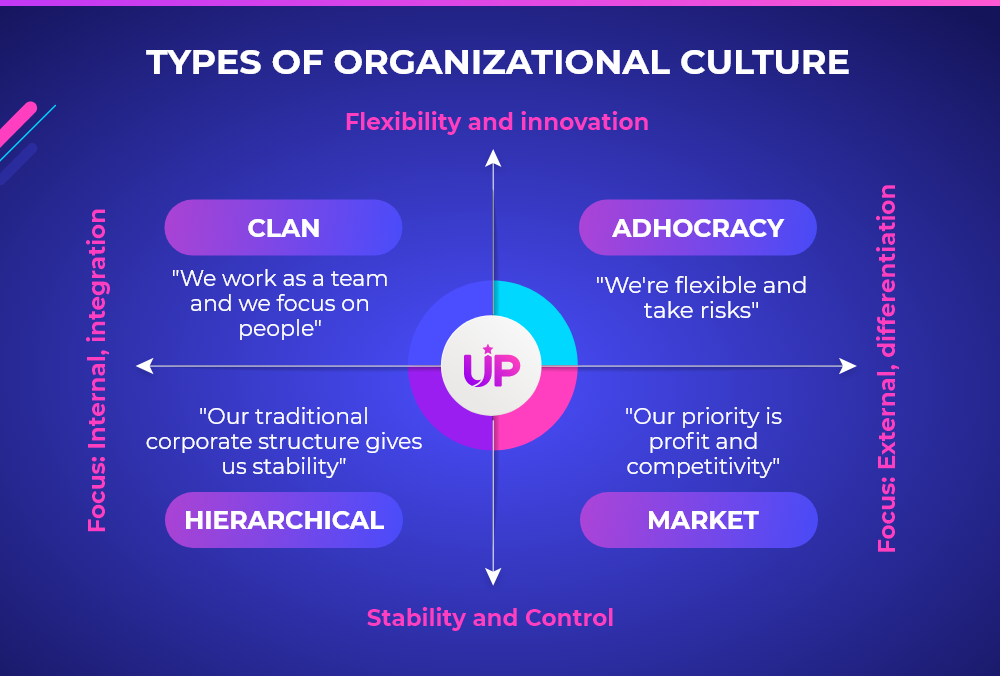What is Organizational Culture? Build the identity your company needs
Written by María Eugenia Raffaele
What are the different types of organizational culture? What are its elements?
Did you know that organizational culture is the alma mater of your company? When organizations build a solid culture, focused on the employee experience, setting clear values and competencies, they turn their community into a great team that stays motivated to give their best everyday.
We invite you to understand what corporate culture is and find out why it is important to build it. Today may be the day you begin to navigate the experience of a cultural transformation that will give you the identity you need.
What is organizational culture and why is it so important?
If you got this far and you really want to know what organizational culture is and why it’s so important to build one, we suggest you dive into our post and find out everything you need to know to start reflecting about your culture today.
Let’s go step by step.
What is organizational culture?
The company, corporate, or organizational culture (we will use these terms as synonyms throughout the text) according to authors such as Edgar Schein and Idalberto Chiavenato, refers to the system of beliefs and values shared across an organization – from the management to the administrative staff, including their relationship with suppliers, clients and even the recruitment department. This system is the core of the what, how and why of the company, as it guides daily behaviors and, above all, defines the vision it has of itself and the environment. It is easy to say, but the truth is that this issue arouses debate, doubts and contradictions, given that there is little consensus regarding the definition of corporate culture and the impact it has on our teams.
Next, we will delve into the elements of corporate culture, their importance, the types of culture that exist and how they work, so that you can make an evaluation and diagnosis of your organizational culture and nurture it over time.
What are the elements of organizational culture?
Each culture is unique and its elements are specific to each organization, but in order to help you define the pillars that will give life to your culture, we’d like to share the elements we consider essential for any culture.

Organizational culture: elements in-depth
Skills and Values: Yes, skills, values and culture go hand in hand. Setting clear values and competencies is essential to define a common purpose and foster a sense of belonging, trust and identity. The problem is that, despite values and competencies are the foundations of every company, many do not have them, and in other cases, they are used as synonyms despite their distinctive differences. So let’s define them simply below:
- Values will be what distinguish you from the rest. Honesty, creativity, trust, etc. will help us understand why we behave and carry out actions in a certain way, and all this represents the identity of a company. Unfortunately, only 41% of employees know what the identity of their company is, so we suggest you start reflecting on your beliefs and values, and how you transmit them across your organization.
- Competencies define the knowledge, skills and abilities that you aspire to develop and promote among your talents. Innovation, leadership, and teamwork, for example, are competencies that will make each process and result more productive and meaningful.
How to define them? This article will serve as a guide to start developing a culture of values with unique competencies that will lead you to success.
- Communication and organizational culture: How clearly and effectively do you communicate? When communication is one of the elements of corporate culture, teamwork is more articulated, there’s greater trust, clearer objectives, and stronger human relationships. This way, you will avoid the consequences of poor communication, such as: uncertain direction, unnecessary duplication of tasks, decreased teamwork, and backlash in decision-making.
How to improve communication? Here’s how you can enhance collaboration and transparency, and improve your corporate dynamics with effective communication.
- Vision: Does your community have a common purpose? Where is your organization heading? Are they all going the same direction or only you know where you want to go? The foundation of any company culture is its vision, and by it, we mean the long-term goal that will provide guidance to your community. Bear in mind that a well-defined vision will act as a common thread for all behaviors and aspects of your business. When you lack vision, your company lacks coherence and focus. So, if you have not yet defined your vision, it is time you start including it as a key element of your business culture.
- Professional development: Regardless of the type of culture you build (we will specify the types later), you must make sure your employees count with the necessary tools to grow professionally. When continuous learning becomes part of your culture, you will have more updated and adaptable teams. Remember that an organizational culture that encourages professional growth and development will empower your talents and better prepare them for the future.
How to make professional development and continuous learning a key element of your organizational culture? We suggest you read this article about the importance of promoting professional development in your organization. Make your talents acquire valuable knowledge and experiences, while you obtain greater business efficiency, and commitment across your company.
- Work climate: As you may have noticed so far, culture is tangible, and the cultural environment of a company will be reflected in the climate of your organization. Just as it can positively affect your talents, it can also affect them negatively. When the work environment is one of the elements of your organizational culture, you will be 3.6 more likely to have committed and united employees, willing to make the best of themselves for the benefit of the entire community.
- Leadership: Among the 6 elements of organizational culture that we’re pointing out, effective leadership is a fundamental pillar to build a successful organizational culture, since it is your leaders who keep it growing everyday. When they have the institutional culture in their DNA, your employees will see the culture reflected in each of their behaviors. To achieve this, you need to make sure you nurture leaders who:
- encourage creativity,
- empower your teams with active listening, giving them a voice, and enhancing their professional development through continuous learning,
- make your organization an inclusive community where all voices have value,
- recognize from the smallest daily actions to great individual and group achievements, making these recognitions visible to the whole community,
- promote constant feedback,
- convey the values and vision of your company by giving the example,
- have empathy for your teams and promote their well-being to generate greater commitment and thus avoid wear and tear caused by daily stress, and
- use communication as a master key to open dialogue and active listening through 1:1 meetings, job satisfaction surveys, genuine conversations.
You must have noticed that in order to ensure all the elements of an organizational culture work and align with the personal culture and goals of each of your talents, you must create a community of leaders who make this possible. Find out what the characteristics of a successful leader are and how to foster a leadership culture that will take the experience of your employees to the next level.
Why is a strong culture important for organizational success?
We hope by now it’s crystal clear what organizational culture is and what its key elements are. Let us now turn to the functions of organizational culture.
If you are still wondering why organizational culture is important, imagine for a moment that a company has an important new customer and, although it represents a growth opportunity, it’s also a great challenge. Now, look inside the culture of that company. How do teams receive the news about this new challenge? How will they deal with it? If your culture is one in which people are expected to follow top-down rules, or where employees do not have a sense of belonging, they will have many difficulties adapting to the new situation, and this will bring about confusion, demotivation and great stress. In short, the promising growth opportunity turned into chaos!
So, what are the basic functions of organizational culture? A solid and healthy organizational culture, with elements such as those we mentioned above will:

How does culture influence an organization?
A healthy organizational culture, focused on collaborative work and professional development, among other things, will have an immediate impact on the organization. The changes generated by cultural transformations are surprising and you will not only see them reflected in daily processes and results, but also on the faces of your employees.
Although each company chooses what type of culture it wants to build, and the elements vary from one to another, we will take the ones mentioned above so that you can see with your own eyes how culture influences a company:

Organizational culture: types and real examples
If you are looking for ways to build your organizational culture from scratch, transform it or simply strengthen it, it’s essential that you familiarize yourself with the types of organizational culture that exist.
A quick Google search will bring up thousands of articles describing different types of corporate cultures. However, we will share four models of culture taking two polarities determined by Robert E. Quinn and Kim S. Cameron, two researchers from the University of Michigan.
We will specify the characteristics, benefits and limits of each organizational culture to help you determine what you want and what you don’t for the future of your company.

Here we see four types of corporate culture: clan culture, hierarchical culture, market culture, and adhocracy culture. Let’s see below what they are about and their limitations.
Type: Clan
“We work as a team and we focus on people”
This type of organizational culture represents “feeling like home.” They are organizations that are closely bonded, where everyone works together as a community, and they tend to put people’s needs, collaborative work, recognition and communication first. They have a horizontal structure and promote professional development and autonomy. It is flexible by nature.
Benefits:
- Great commitment and sense of belonging.
- Happy employees = Happy customers
- Highly adaptable to change
- Great possibility of growth in the market
Limitations:
- It is a great challenge to maintain the culture as the company grows
- It needs leaders who have culture in their DNA to be able to transmit it to the entire community.

Type: Adhocracy
“We are flexible and take risks”
The adhocracy organizational culture model describes an organization in which leaders are reactive and receptive to change. Its main objective is to encourage teams to turn projects “upside down” and redefine goals when necessary quickly and effectively. In contrast to the traditional hierarchical model, this one is enriched by new challenges, as they provide an opportunity to promote individual creativity, sharing and innovation.
Profits:
- Constant innovation and creativity
- Flexible working conditions
- Dynamism.
Limitations
- Well, risk is risk… There is always the possibility that, especially in a new company, they will not obtain good results.
- They encourage competition among colleagues.
- Pressure to propose new ideas.
Type: Market
“Our priority is profit and competitivity”
In this type of company culture, competition, profitability, and differentiation are the pillars of growth. The team “comes out to win” and success is measured and evaluated in relation to the profitability of the final results. Since each position has an objective, sometimes there’s a certain lack of connection between colleagues and leaders.
Benefits:
- Generally assured profitability
- Clear objectives that support every action
Limitations:
- External success is prioritized over internal satisfaction
- Little compromise
- Demotivation generated by poor professional development.
Type: Hierarchical
“Our traditional corporate structure gives us stability”
This model of corporate culture is the most rigid, formal and traditional corporate structure. They are companies that focus on a clear chain of command and multiple levels of management which separate employees and leadership. There are established codes and ways of doing things determined by high-ranking positions.
Benefits:
- Predictability
- Stability
- Direction
Limitations:
- Reluctant to risk
- Little flexibility
- Lack of adaptation
- Little creativity
- Doesn’t encourage feedback
And now? What else do you need to know about organizational culture? Examples!
Let’s look at some concrete examples that reflect each of the models described above.
Hierarchical culture: In general, this type of culture can be found at both ends of the corporate spectrum – from “old school” organizations in the customer service industry to fast food restaurants. These are companies that are very focused on how day-to-day operations are carried out and are generally not interested in making any organizational culture change in the short term.
Market culture: General Electric and KIA Motors are two companies with a market organizational culture. Their goal is to be the best in their industry, which is why they are often big and established leading companies. They seek to compete and beat anyone else that can be compared.
Adhocracy culture: If you are looking for real examples of companies that embody external focus and risk taking, think about the culture of Google, the culture of Facebook, or the culture of Apple. These corporations run on creative energy and are constantly innovating. Adhocracy cultures are very common within the tech industry as they are constantly changing, developing and launching new products regularly.
Clan Culture: Companies with a large percentage of employees working remotely, or the creators of HR technology who help other companies to reinvent themselves through technology, for example, are adaptable, team-oriented organizations with a horizontal structure that emphasize collaboration and communication. Globant is an example of an adaptable organizational culture, in which success is measured in relation to human bonds, processes, constant feedback, recognition, and professional development.
How do you create an organizational culture?
In order to develop a solid corporate culture that you can sustain over time, it is important that you identify your starting point.

Once you identify the step you are on today, we suggest you consider these suggestions:
- Include and listen to the voice of all those who make up your corporation.
- Ask yourself what goals you are looking for, how you want your talents to interact, and what air people breathe in your company.
- Make a diagnosis that gives you perspective and start planning the actions you can take to experience the cultural transformation you need.
- Think outside the box! It is not necessary that you follow only one of the models we mentioned above. Feel free to take the elements that align with what you seek to create. There are no good or bad role models – they all have their benefits and limitations. However, do make sure to put your collaborators at the center and foster bonding, trust, and professional development in an inclusive way.
- Whichever model of culture you choose to build, make sure it responds to the needs of the new world of work. Creating a digital culture will optimize the processes and results you seek.
How do you maintain an organizational culture?
Once the foundations of your corporate culture have been established, you must make sure that it becomes part of all your community. Culture must be present in every corner of your organization and planning how you will carry this out is essential for it to strengthen and continue to grow over time.
- Create habits and enforce them through example (especially by your leaders)
- Think of team building activities that strengthen your teams.
- Connect with people’s emotions and needs
- Promote continuous feedback and recognition.
- Make your collaborators visible, so that the culture is transmitted to everyone through actions that have a positive impact on the entire organization.
- Make technology your best ally. Make sure you have tools that encourage fluid communication and links like Slack, Microsoft Teams. There are also solutions like StarMeUp that can help you create an inclusive, people-centered company culture, in which daily processes and decisions are more effective and agile thanks to technology and AI.
- Maintain coherence in daily behaviors, messages and values so that the company’s expectations and objectives are aligned to a healthy context, which promotes commitment, professional development, collaborative work, and inclusion among human beings.